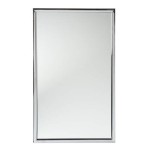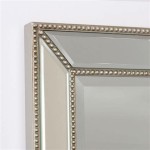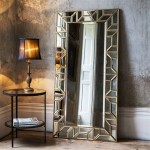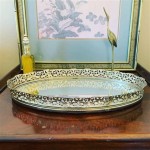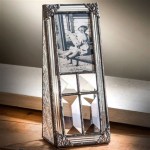Victorian Style Mirrors: A Reflection of Elegance and History
Victorian style mirrors represent a distinct category within the broader world of antique and vintage mirrors. Characterized by ornate detailing and often substantial size, these mirrors offer a glimpse into the aesthetic sensibilities of the Victorian era (1837-1901), a period marked by rapid industrialization, burgeoning wealth among the middle class, and a revival of historical design influences.
The Victorian era witnessed a surge in the production of decorative arts, driven by advancements in manufacturing techniques like glassmaking and metalworking. This increased accessibility to decor previously exclusive to the aristocracy facilitated a boom in domestic ornamentation, with mirrors playing a significant role. No longer simply utilitarian objects, mirrors became integral decorative elements, reflecting both light and the growing prosperity within Victorian homes.
One of the defining features of Victorian style mirrors is their elaborate frames. These frames often incorporated a variety of materials, including wood, gesso, plaster, and metal. Carved wood frames, frequently embellished with intricate floral motifs, foliate designs, and stylized scrolls, were particularly popular. Gilding, achieved using gold leaf or paint, added a touch of opulence, reflecting the Victorian penchant for lavish ornamentation.
The influence of historical revival styles is evident in many Victorian mirror designs. Gothic Revival, characterized by pointed arches and intricate tracery, found its way into mirror frames, lending them a dramatic and architectural quality. Renaissance Revival mirrors, often featuring elaborate carvings inspired by classical motifs, offered a more formal and stately aesthetic. The Rococo Revival, with its playful asymmetry and shell-like ornamentation, introduced a touch of lightheartedness to Victorian interiors.
Beyond their decorative frames, the mirror plates themselves contribute to the overall aesthetic. While clear, flat glass was common, some Victorian mirrors employed techniques like bevelling or etching to add further visual interest. Bevelling, a process that creates an angled edge around the mirror's perimeter, catches and refracts light, adding a sparkling dimension. Etching, which involves carving designs onto the glass surface, allows for intricate detailing and personalized touches, such as monograms or family crests.
The size and shape of Victorian mirrors varied considerably. Large, overmantel mirrors, designed to be placed above fireplaces, were a prominent feature in many Victorian homes. Their imposing size served to enhance the grandeur of the room, reflecting the light and creating an illusion of greater space. Smaller, handheld mirrors, often featuring exquisitely detailed frames and sometimes inlaid with precious materials, catered to personal grooming needs while simultaneously serving as fashionable accessories.
Cheval mirrors, characterized by their full-length, pivoting design, also gained popularity during the Victorian era. Their practicality and functionality, allowing individuals to view their entire reflection, made them essential additions to bedrooms and dressing rooms. The frames of cheval mirrors often mirrored the ornate styles found in other Victorian mirrors, further contributing to the overall aesthetic cohesion of the space.
Identifying authentic Victorian mirrors requires careful consideration of several factors. The materials used in the frame construction, the stylistic details present, and the overall craftsmanship offer valuable clues. Examining the back of the mirror can also provide insights into its age and authenticity. Old mirror glass often exhibits slight imperfections and waviness, which are characteristic of early glassmaking techniques. Signs of wear and tear, while potentially detracting from the mirror's pristine condition, can paradoxically enhance its authenticity, serving as evidence of its age and history.
Caring for Victorian style mirrors requires a gentle approach. Dusting with a soft cloth is recommended for regular cleaning. Avoid using harsh chemical cleaners, which can damage the delicate frame materials and the mirror surface. For stubborn dirt or grime, a slightly damp cloth can be used, followed by immediate drying. When handling antique mirrors, it is crucial to support the frame adequately to prevent stress on the glass and avoid potential damage.
Victorian style mirrors offer a timeless elegance that continues to resonate with collectors and interior design enthusiasts today. Their intricate details, rich history, and reflective qualities make them more than just functional objects. They are statement pieces, capable of transforming a space and adding a touch of Victorian grandeur to any setting. Whether incorporated into a period-appropriate décor or used as a contrasting element in a more contemporary setting, Victorian style mirrors remain a captivating reflection of a bygone era.

French Victorian Style Gilt Oval Wall Mirror

Victorian Style Guilded Mirror For In Ct Middlebury Furniture And Home Design

Victorian Mirrors The Emporium

Lombardo Wall Mirror Burnished Gold Ornate Elegant Victorian Style

Antique Victorian Mirrors

Classic Victorian Antique Silver Leaf Mirror Made In Italy Louis Xiv Italian Baroque Wall Ornate Luxury 8053

Antique Victorian Style Wall Mirror

Thornwood Manor Victorian Dressing Mirror Af7245 Design Toscano

The History Of Mirror And Its Evolving Style Through Ages

Touch Of Class Victorian Style Anwen Wall Mirror Ornate Gold Antique Vintage Framework Royal Mirrors For Bathroom Bedroom 44 Inches High Metal Frame

